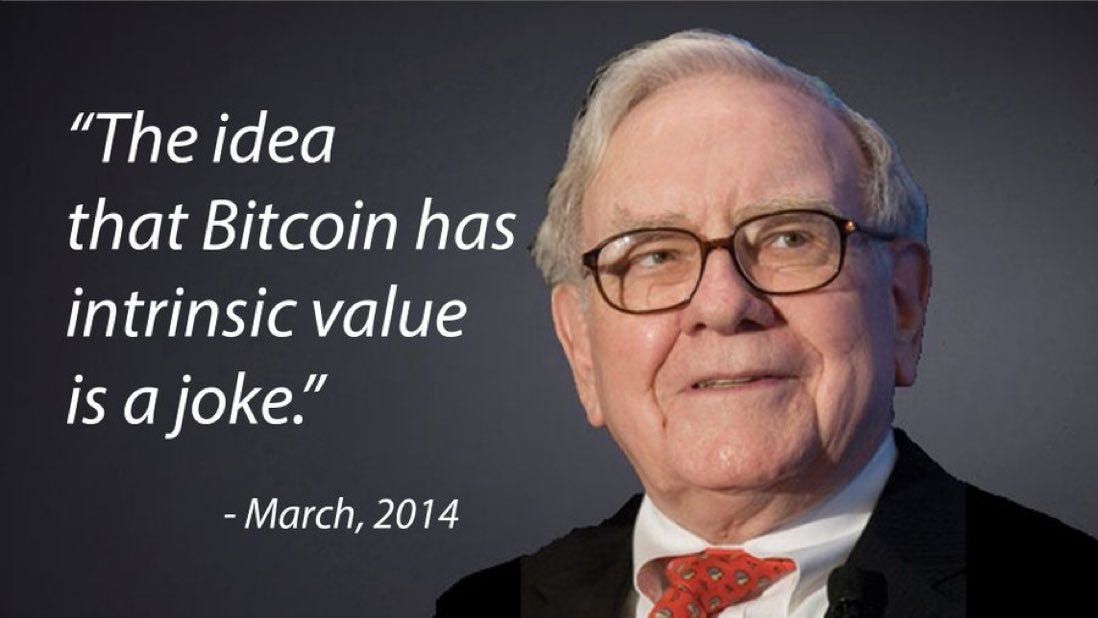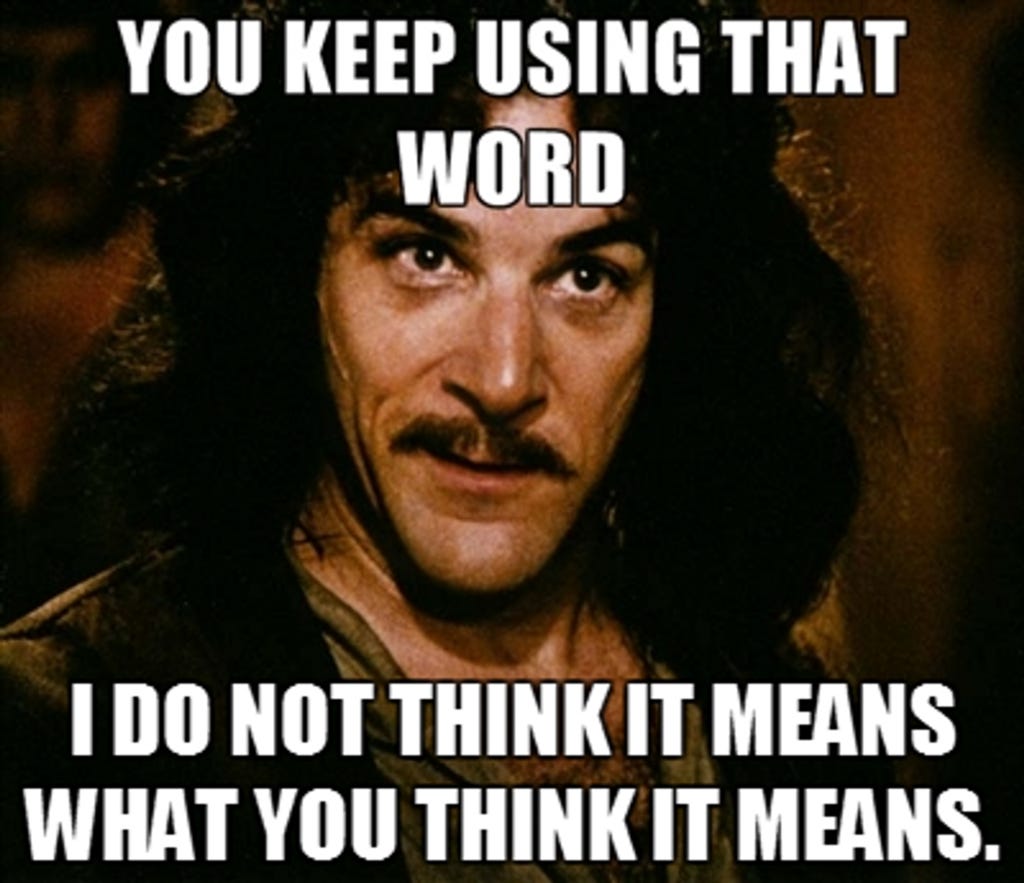Crypto, Stocks, Hammers, Gold, & The Meaning of Intrinsic Value
Crypto isn’t worth anything because it has no “intrinsic value”. No one applies this term consistently. Let's deconstruct this amorphous phrase.
A common refrain from crypto detractors is it’s not worth anything because it has no “intrinsic value” (IV).
No one applies this term consistently. We use IV arguments to tout what we already like, and to disparage the things we don’t. It’s an amorphous term that takes on whatever shape suits your priors.
I’d like to dissect what intrinsic value really means. There are two different definitions: The Hammer Method and the DCF Method.
The Hammer Method
The core meaning of intrinsic value is something has real-life utility, independent of a market price assigned to it. For example: pretend there’s a market for my shoes, and that market offer was $0. Do they have zero value?
No, because they have genuine utility. They protect my feet, I use them to walk. Their value is not dependent on their market price. The innate, intrinsic value for them is their utility. A market price doesn’t make them any more or less useful.
My car has IV, it performs tasks I need to exist. The hammer in my toolbox has IV. My home has IV, it shelters me. Glue and cardboard boxes have IV. Your Playstation has negative IV, because it wastes time (ha, kidding. Sort of.)
What is the IV amount? That’s subjective. But the point is intrinsic value means something has value independent of its financial price. You could value all these things at $0 and they’re still not worthless. Typically the market would never assign such a price to useful things, but the point is their utility is not a product of their price.
No one thinks in these terms when they judge the IV of something. But almost everyone who criticizes crypto as having no IV implicitly uses it this way. It’s a post-hoc, pseudo-insightful definition they don’t apply to anything else, when really they just don’t like crypto. Many such cases!
We'll call this primary intrinsic value definition the Hammer Method.
The DCF Method
The second, more-common definition of IV references an asset’s discounted cash flows (DCF). When TradFi guys talk about IV, 97% of the time they mean how much cash the asset returns over its lifetime. To be clear, this is really extrinsic value, because the price is basically part of, or entirely, the utility here.
Technically a stock’s IV (AKA the company’s market cap) is the sum of all the cashflows the business will generate during its existence, discounted back to today. Projecting those cashflows is an approximation and art at best.
Bonds are valued similarly, though due to their defined duration, coupon, and return of principal they have more concrete valuations and pricing. Interest rates can make their market prices fluctuate substantially, but what the bond will provide you over its life is quite predictable.
However not all stocks pay a dividend, and the most richly valued ones (tech stocks) often don't. Only 50% of the Nasdaq pays a dividend. No cash will be returned to you from many stocks. A stock with no dividends or book value is just an “equity” abstraction, and functionally does not have any DCF IV because shareholders never see a dime of those cashflows (I’ve never heard Buffett criticize tech stocks on IV grounds, oddly).
It’s “equity” but what does that actually mean, concretely? You have no claim on company assets or cashflows. You can basically just vote with it. I deconstruct this in thorough detail in Governance Tokens, Tech Stocks, Dividends, and "Utility". If you’re a finance guy and your visceral response was “no that’s not true”, read the linked essay.
So what do most tech stocks represent insofar as IV?
They derive their value from the stock price going up as revenue, margins, and company cashflows grow. This is money you’ll never touch as a shareholder, but through some finance law of physics it shows up in the stock price. No TradFi guy will disparage anything listed on the Nasdaq for having no IV, even though its valuation is essentially operating on the same presuppositions of many crypto governance tokens.
We’ll call this second IV definition the DCF Method.
The Hammer Method or the DCF Method, Which Applies?
Most use the Hammer Method when disparaging crypto. But they only apply the DCF Method to their stocks, even when DCF assumptions are simply abstractions or more correctly understood as extrinsic value. Or, they overlook that the DCF Method would give some crypto IV as well: such as stETH, which pays a dividend. Or L1s like ETH, SOL, FTM, etc. which have real cashflows generated by their networks and are effectively commodities.
Hypocrisy.
Application of These Methods
Fiat currencies:
These have zero DCF or Hammer Method IV. The utility of fiat is predicated on a market consensus they can be used to transact (medium of exchange).
Let’s apply the Hammer Test to fiat: if the market assigned it a zero value, would it be valueless? It would. If something’s utility is dependent on its market price, then it fails the Hammer Test. The Hammer Method heuristic is “if this was priced at zero, would it still be useful?”.
It isn’t edgy to describe currencies as having no IV, but it’s important to emphasize the same people who dismiss crypto on IV grounds have no issue that the currencies they store their wealth in have none of it. The point of this "intrinsic value" breakdown is to expose inconsistencies and hypocrisy.
Gold:
It trades around $2k/ounce due to a centuries-old Lindy effect that believes it’s a store of value (SoV). It’s just a belief, but it’s a very old, deeply ingrained one. However if the market assigned a $0 price to gold, it would have a little bit of Hammer IV as a contact metal for electronics. This is a very autistic point, but gold is a good conductor of electricity and heat and that has utility beyond its market price. This has like zero bearing on why it’s $2k an ounce though; no one owns gold because of its heat conductivity.
I’m also open to giving gold some Hammer IV points as a bartering tool, since even with no market value many would still accept it in exchange for goods. This is a self-referencing Lindy point, in a way. The SoV bartering utility would likely transcend a market price (imagine if all markets said gold was worth $0, guys would still want it). I admit this is a subjective hypothetical, gold is an odd one.
But if we’re being candid, gold has no IV. It doesn’t do anything. It’s valuable because reasons.
Final Thoughts
Hammer Method Intrinsic Value: even when priced at $0, things that provide utility have Hammer IV (shoes, homes, cars, etc.). Gold has some. Stocks, currencies, crypto, and financial assets have none. Some crypto that achieves Lindy SoV beliefs (BTC, ETH) may eventually have Hammer IV as a bartering tool the same way gold does (subjective).
DCF Method Intrinsic Value: assets that return cashflows have DCF IV. Bonds have the purest form of it. Stocks with no dividends or book value functionally don't have any (unless you're doing a hostile takeover). Currencies and gold have none. Some crypto has DCF IV when it pays a dividend or has cashflows generated from network/product use (eg. stETH or SOL).
Who’s the only type-of-guy with no intrinsic value hypocrisy…
If you come across someone who thinks stocks, gold, crypto, fiat, etc. all have no IV by consistently applying the same pure Hammer reasoning, then you’ve met a Hammer Maximalist. Please shake that man’s hand because at least he’s consistent with his viewpoints. You should probably befriend him too, since I’m sure he knows how to hunt, forage, farm, and has a hidden bunker somewhere. Good guy to keep around.
When advocating for DeFi and crypto, it’s important to illustrate by way of example and logic how many crypto criticisms also apply to things people already own and accept as valuable. I encourage you to challenge people to be consistent with their stated beliefs.
Crypto detractors essentially dislike new things they don’t fully understand, with it masquerading as this high-minded critique. DeFi disintermediates gatekeepers of financial systems, perhaps that’s why you actually hate it? If that’s why, good, you should fear it. I look forward to you hating it even more. But don’t manipulate the term “intrinsic value”, just say you don’t like it. Own it.
Follow @BackTheBunny







nice write up!
You consistently put out good commentary and intelligent pro-crypto viewpoints. Thank you!